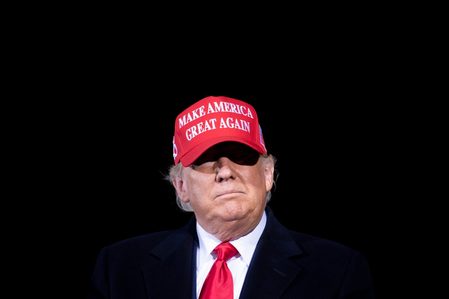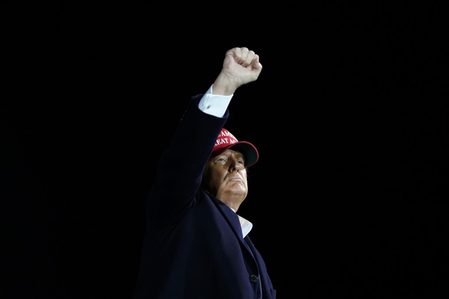SUMMARY
This is AI generated summarization, which may have errors. For context, always refer to the full article.
![[ANALYSIS] Harnessing fear and resentment: Right wing populism and the US elections](https://www.rappler.com/tachyon/2020/11/right-republican-party-democrats-november-19-2020.jpg)
The first results the day after the election, November 4, provoked pessimism. One pundit said, “There was a loser on election night. It was America.” It looked for a while as if Trump might actually get reelected. Results in the next couple of days brought relief. By Friday evening it became clear that Trump had lost.
Although Joe Biden’s victory is unequivocal – he will have more than 5 million votes over Trump – some on the Left belittle the victory. It is one thing for the Wall Street Journal to editorialize that Biden has no mandate; I feel sad that Naomi Klein found it hard to celebrate. If I was in the US, I would have danced on the streets together with the tens of thousands who partook of the joy of getting rid of Trump.
The contours of Biden’s victory will continue to be analyzed beyond his inauguration on January 20, 2021. It’s not just that he rebuilt the “blue wall” in the “rust belt”of Michigan, Wisconsin, and Pennsylvania that Trump won in 2016; he flipped 5 red states. I especially enjoy the poetic justice of Biden having flipped the 2016 electoral college votes of Trump 306 to 232. What disturbs me and many on the US Left is that Trump won 72 million votes. The question is why?
Political economy of populism
To understand Trumpian populism, we have to look at what has happened to the US economy in the past decades. We don’t have to enter into debates about imperial decline. There are a few developments that cannot be challenged. The international dominance of the US economy since the end of WW2 diminished as other economies, Western Europe, China, the BRICS, developed. Building supply chains and taking advantage of lower wages in other countries, American transnationals moved more and more manufacturing outside of the US.
The Trumpian challenge in the “rust belt” rests on the decline of manufacturing. This combined with demographic changes which pushed economic change to urban areas, to more and more knowledge-based industries. “America’s divisions go far deeper…driven by divergent trajectories of growth and decline in different places. The rift, as in most developed countries, grew between knowledge workers in the prosperous and socially progressive metropolitan areas that formed the hubs of the new global economy, and the conservative, non-college-educated inhabitants of rural areas and post-industrial towns.” Urban areas are also centers of higher education, culture, and media. It is partly for this reason that Black, Latinx, and Asian American population growth is fastest in urban areas.
This direction of change is likely to continue. It is the product of economic forces, domestic and international, that is beyond the control of any one government. This does not mean that the US government cannot respond to the way these changes have affected people’s lives – the joblessness, hopelessness, family dissolution, and “deaths of despair” that poison lives in rural areas and those left behind by factories relocating to other places. There are policy changes identified by Bernie Sanders and Elizabeth Warren that Biden can adopt.
Cutting across geographic and demographic differentiation is the more generalized advance of inequality, built on decades-long stagnation of real wages and the scandalous rise of management salaries. The American middle class has been decimated. It is difficult to believe that there are large pockets of poverty in the richest country in the world. When you combine this with inadequate social services, you have millions who live a hand-to-mouth existence.
In a recent Guardian article, Robert Reich came up with startling statistics. “…if America’s distribution of income had remained the same as it was in the 3 decades following the Second World War, the bottom 90% would now be $47 trillion richer. A low-income American earning $35,000 this year would be earning $61,000. A college-educated worker now earning $72,000 would be earning $120,000. Overall, the grotesque surge in inequality that began 40 years ago is costing the median American worker $42,000 per year.”
This is buttressed by the dominance of neoliberal ideology cutting across both the Republican and Democratic parties. “Trump’s anti-establishment shtick proved hollow, but he tapped into legitimate outrage against the ways in which both parties permitted elites and special interests to capture so much of the economy through tax dodges, anti-competitive arrangements, and outright corruption.”
It is clear that the two parties have responded to these changes in distinctly different ways. The Democratic Party moved away from its traditional base among blue collar workers and began to be more identified with professional elites and college-educated voters in coastal areas in both the East and the West. Republicans gravitated towards rural and small town areas, to older, non-college educated people. Republicans consolidated support among white voters, Democrats made up the loss of support among whites with support among Blacks and other colored people.
These developments preceded Trump. What he did was to harness, to weaponize, the fear and resentment among the victims of these changes. Whether he did this consciously or not, Trump constructed the basic elements of right wing populism. The most important, an “us and them” frame. “Us” and the rest of the world, most importantly China which poses the biggest challenge to American international dominance. “Us” and migrants, especially Latinx migrants. Most importantly, “us” and Blacks because slavery and its “tail,” racism, has historically been a crucial glue for American society.
“Black Lives Matter” was not just in response to George Floyd and other Blacks killed by police; it was also in reaction to the racism which was an essential part of Trump’s right wing populism. Before Trump, Obama probably inadvertently contributed to racist resurgence. For many white Americans, it was not just that a Black sat in the White House for two terms, Barack Obama’s poise and eloquence has made him, to this day, one of the most popular politicians in America. The amazing scope and staying power of “Black Lives Movement” cannot but have stirred fear among racists.
“Us” against the “establishment is another key element of right wing populism. But instead of working against the economic and political establishment, Trump and other right wing populists such as Duterte and Bolsonaro have actually worked to consolidate “establishment” control of the economy through tax cuts and the removal of environmental and other restraints. Because social democratic and other left-of-center parties have largely adopted neoliberal economic policies, they have not been able to provide political alternatives.
Given the neoliberal consensus among ruling groups in the US and Western Europe, the struggle over control of private and public economic resources, the bread and butter of most politics, has made way for cultural and religious issues. To Trump supporters, it does not matter that Trump has done more for the rich than for them. What matters is that he defends their right to own and parade guns; he has made it somewhat respectable to be racist, to believe in outlandish conspiracies, to be sexist. Beleaguered by urban secularism, evangelical Christians like Trump’s support on abortion. As one analyst put it, Trump is the middle finger that enables his supporters to flip urban snobs they hate.
Contours of the task
The reason why parts of the American Left are disappointed by Biden’s victory is that they maybe not expected but wanted a “blue tsunami” that would wipe out not just Trump but the Trumpist version of right wing populism. The problem with this is that it misunderstands, actually belittles, the magnitude of the task for progressives. No “blue wave” is possible as long as Republicans are better at responding to white fears and frustrations than Democrats. Whites continue to constitute 65% of the US electorate. 57% of white voters chose to reelect Trump; only 42% voted for Joe Biden.
Republicans understand that, long term, this is not enough. Sectors of the white demographic – seniors turned off by Trump’s depreciation of the COVID-19 risk, young people, suburban women, urban college educated – are turning to the Democrats. Whites are not going to become a minority until roughly 2040, but already a majority of the nation’s 74 million children are non-white. Conservative Republicans believe that the more people, especially non-whites, vote, the lesser their chances for victory. Thus the campaign against mail-in voting, manipulation of the postal service, and outright vote suppression.
Support for Biden in the non-white population made up for his disadvantages among whites. 87% of Black voters, 66% of Latinx voters, and 63% of Asian American voters chose Biden. Latinx voters contributed to Biden’s victory in Arizona and Nevada, but their support for Trump kept Florida and Texas red. Latinx constitute almost 60 million, represent more than 15 origin countries and encompass a range of generational, socioeconomic and religious identities. Latinx whites are not exactly strangers to racism. Asian Americans have been slowly moving to the Democrats but continue to be played off against Blacks and Latinx and held up as “good” “industrious” non-whites.
The direction of economic and demographic change are in the Democrats’ favor. The 490 counties Biden won account for 70% of GDP, Trump’s 2,534 counties only 30%. But transforming this to electoral advantage, concretely, by winning in the 2022 midterm and 2024 presidential elections, is not going to be easy. Biden and Harris won but Democratic control of the House has been weakened and control of the Senate still has to be fought in Georgia in January. There were no large Democratic gains in down ballot positions at the state and lower levels.
The first task of the Left is to push the Biden administration to abandon Democratic party support for neoliberal policies going back to Bill Clinton. This cannot be done through ideological posturing. It has to be carved – negotiated – into specific policies. The culture wars is treacherous terrain for the Democratic party though issue-based groups will undoubtedly do battle here. It may be difficult to directly confront rural white fears and resentments, but if their economic needs are met, that would already be a substantial beginning.
Two weeks after the election there is increasing concern over Trump’s refusal to concede defeat. There are practical problems with a postponed transition, with security issues especially over Trump’s removal of key officials in the Department of National Defense, with the lack of pandemic policy. I am not so worried that Trump will refuse to leave when he is supposed to come January 20. Standard Trump practice in politics and business, he wants to keep his supporters worked up over his claims to being cheated, the better to get them to pay his campaign and legal fees, monetizing defeat.
While I believe Trump is a spent force, the right wing is not. Trump may have lost but the Right continues to control the Republican Party, is dominant in many state and other local governments, has a new majority in the Supreme Court and most ominous, is armed. This can be blunted only with policy changes that have to be negotiated not just with Republicans but also within the Democratic Party. The challenge to the Left is to sustain/advance into 2022 the “…leap forward in strength, reach, experience and greater alignment with one another” that made victory possible in 2020. – Rappler.com
Joel Rocamora is a political analyst and a seasoned civil society leader. An activist-scholar, he finished his PhD in Politics, Asian Studies, and International Relations in Cornell University, and had been the head of the Institute for Popular Democracy, the Transnational Institute, and the Akbayan Citizens’ Action Party. He worked in government under former president Benigo Aquino III as the Lead Convenor of the National Anti-Poverty Commission.
Add a comment
How does this make you feel?


There are no comments yet. Add your comment to start the conversation.